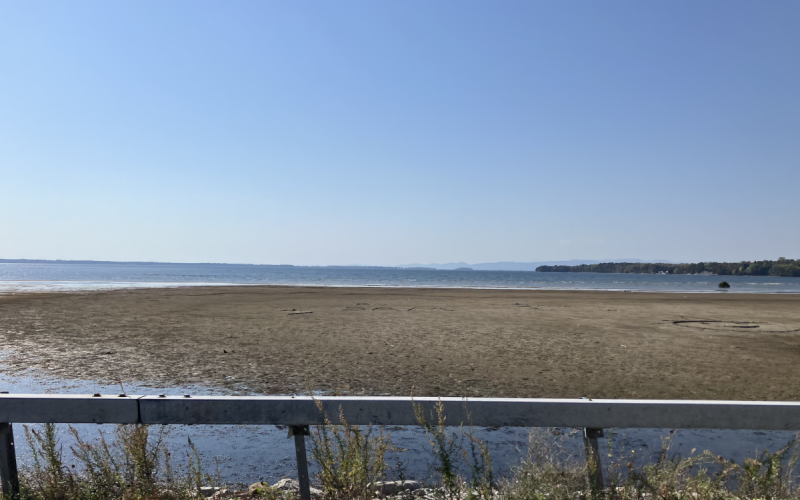
Turning Tides, Turning Seasons: Part One, Fall
This piece is the first installment of a year-long project that will detail the seasonal changes that occur in and around Lake Champlain. Throughout the 4-part series, Turning Tides, Turning Seasons, we will not only examine the “how” and “why” behind these natural changes, but also ask an urgent question: “How are Lake Champlain’s yearly cycles impacted by our rapidly changing climate and landscape?”
Fall is well underway in the Lake Champlain basin. As autumn foliage rounds its peak and the temperature begins to dip its toes into cooler water, less apparent phenological changes are happening beneath the lake’s surface. Shifts in plants, wildlife, and water cycles not only mark the changing seasons, but also reveal the pressures of changing environmental conditions on the region.

Fall sees Lake Champlain at its lowest annual water levels. During hot summer months, evaporation and transpiration (the process of plants emitting water back into the atmosphere) results in water loss. This year, with over 67% of Vermont experiencing extreme drought, the lake’s levels are unusually low. But low water levels aren’t the only change marking the arrival of fall: Lake Champlain is also preparing for one of its most important seasonal shifts.
As temperatures drop, water reaches its maximum density at 39°F, setting off a process called fall turnover. During this period, the warm upper layer of water (the epilimnion) cools and mixes with the cold, nutrient-rich hypolimnion below. This allows for oxygenated water at the surface to reach the depths of Lake Champlain and for temperatures and nutrients to be evenly distributed throughout the water column.
With temperatures continuing to rise in the Lake Champlain basin, delays in fall turnover could result in altered oxygen profiles and nutrient distributions within the lake. Between 1976 and 2005, Lake Champlain warmed over 2.1°F, primarily within the summer and fall months.
Warmer water also comes with a slew of other ecological challenges. Cyanobacteria, one of Lake Champlain’s most notorious foes, grows best in warm temperatures. Fall turnover interrupts this growth when cooler water restores diatom populations. Diatoms are important microscopic algae that form the basis of food webs by feeding zooplankton, a primary food source for many fish species. Delayed turnover could affect when diatoms are present and alter fish habitat and food availability.
Warming water may also impact fish directly by confusing their seasonal timing, since cold water is used as a cue to trigger preparation for winter. As stated by Vermont Fish & Wildlife biologist Shawn Good, “From warm water species such as largemouth and smallmouth bass, northern pike, perch, and walleye, to cold water species like trout and salmon, fish feeding activity really picks up and creates exceptional fishing conditions for anglers [in cooler temperatures].” This seasonal spike in feeding is necessary for fish to stock up on energy before their metabolism slows down for winter.
Similar to fish, birds also use environmental cues to trigger preparation for winter. In the Lake Champlain basin, shorebirds can be seen foraging along mudflats created by Champlain’s low water levels, while warblers gather in mixed-species flocks. By mid-September, raptors such as Broad-winged Hawks are beginning to funnel southward in migrations, and Rough-legged Hawks can be seen arriving for winter. However, warmer falls may result in varied departure times. According to Audubon Vermont, late-season migrants are leaving significantly later in the season, while early migrants are leaving earlier, extending the overall migratory period.
On land, warmer autumns are also reshaping the growing season. Rising temperatures delay leaf senescence (deterioration), which extends the time plants keep their leaves. This alters growing patterns of both native and non-native species, as invasive shrubs such as Morrow’s honeysuckle and Glossy buckthorn take advantage of the warm temperatures and continue photosynthesizing long after native species have dropped their leaves. Although it has yet to be studied if this trend is consistent across non-native aquatic species, general trends point to how warmer temperatures allow certain non-natives to out-compete natives.
So, what does this mean for those of us living within the Lake Champlain basin? Recreationally, autumn on Lake Champlain brings both opportunities and challenges. Tourism thrives with activities such as leaf-peeping, fishing, and boating, but ultimately, changing environmental conditions are beginning to disrupt our familiar rhythms. 2024 saw the hottest Vermont autumn in the past 150 years, with 2025 seeing similar spikes in temperature this October. If these trends persist, ecological shifts will continue to ripple throughout the Basin at the expense of residents and industries.
In this way, autumn is so much more than colorful foliage and sweater weather aesthetics. It’s a period of ecological transition that reminds us that Lake Champlain is alive and deeply intertwined with our rapidly changing landscape.